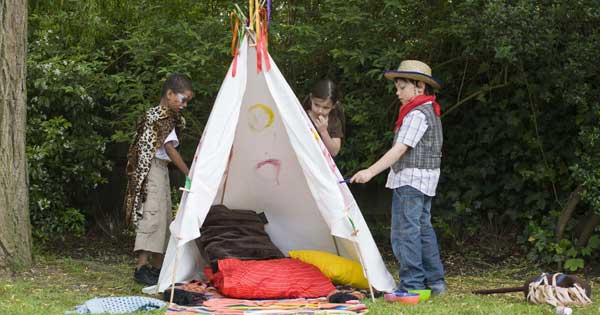So you’ve bought them the junior gardening gloves, mini-forks and little wheelbarrows to get your kids in the mood for gardening – but when all the planting’s done, what’s next?
Well, other enticements might include a den, tucked away from the adults, preferably in a shady part of the garden that will not suffer from high use with little ones coming in and out all the time.

To do it quickly, establish some shelter and fast-growing cover using plants such as willows. For an improvised hideaway, create a simple teepee from willow canes pushed in the ground in a circle and tied together at the top. If you want something prettier for next year, plant climbers such as clematis to climb up the canes in spring to provide flower cover.
A treehouse may be the ultimate den, but it can be costly and complicated to erect if you’re not a natural DIY-er, so you may be better off letting kids make their own den.
Leave a wild area for them to roam around in, preferably towards the back of the garden, but where you can keep an eye on them, providing a variety of twiggy sticks, plants and wood and let their imagination run wild. They can make their own camps using old curtains, old sheets, blankets and pegs.
Sandpits provide young children with hours of fun, whether you buy a plastic one with a lid on it or a more permanent fixture made from a circle of logs set vertically into the ground or from a cleaned-up tractor or lorry tyre.
Use sand that is sold specifically for playpits, as it is non-toxic and won’t harm children, animals, lawns or borders if accidentally spilt. Public play areas and sandpits with high use tend to replace the sand annually, but it is not always necessary to do this if you keep the pit covered when not in use.
It’s worth drying it out regularly, though, as bacteria and other bugs can breed in sand that is continually wet.
Create a wildlife garden for kids. Planting should ideally be done in the spring when you can sow a wildflower meadow and feature a good variety of plants including shrubs, hedges and trees as well as winter berries. Create a bed featuring wildflowers which will grow on poor soils, including meadow clary (Salvia pratensis) and red campion (Silene dioica) along with nectar-rich open-centred flowers including poppies, catmint, sedums and herbs such as lavender, mint and thyme.
Help the kids make an insect house using old pieces of bamboo cane inserted into a small wooden frame or terracotta pot, and put out bird feeders and baths, nesting boxes and hedgehog and insect houses in this new wildlife space while the kids make a log pile in which insects and mammals can shelter. Treat them to a wildlife identification guide, so they can tell you what they’ve seen and a pair of binoculars for a better view.
As play is likely to be at the top of a young family’s agenda, play equipment such as swings and slides could be situated in their own area or integrated into the garden. Rope swings from trees and zip wires (kits are widely available) gently running downwards from one tree to another can soon be dismantled once the children lose interest.
If you are creating an area for the children, there are many plants to avoid because they are either poisonous or irritate the skin including monkshood (aconitum), euphorbia, laburnum, daphne, digitalis, colchicum and taxus, although the list is pretty long, so it’s probably wiser to teach children about the dangers of plants.
newsletter.html”]
Make outdoor space a fun place
